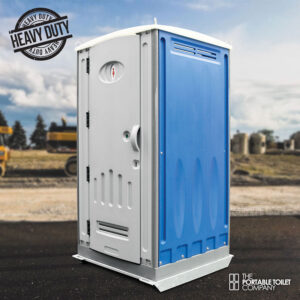You’ve seen them at kids’ baseball fields, construction sites, and outdoor events – portable washrooms that allow you to address nature’s call without leaving the venue. But how does Portable Restroom Trailer Rental work?
Portable toilets (also known as porta-potties or porta-johns) are a staple of festivals, fairs, and other large outdoor areas. ADA-compliant and fully stocked, they provide convenient restroom options for everyone at your event.

The primary function of a portable toilet is to provide users with a safe and sanitary place to do their business. These makeshift restrooms are used at construction sites, outdoor parking lots, and other work environments that lack access to traditional plumbing, as well as at large outdoor events such as music festivals, state fairs, parks, and more.
These portable toilets have a tank that collects human waste and contains a formulation to actively degrade it, as well as odor control technology. They are designed with a toilet seat, and may have a sink or hand washing area for additional user convenience. Most models have a door that locks, and they can be set up in a number of configurations to suit the needs of your event.
Porta potties are usually blue, green, beige or orange and look very similar to a standard bathroom. They are typically standalone units without any extra amenities like sinks or urinals, and they drop off at your site squeaky clean and fully stocked with paper towels and hand sanitizer. They are emptied and hauled away once the event is over, ready for their next location.
If you are planning to use portable toilets at your event, it is important to choose a location that has easy access and is clear of obstacles. It is also essential to consider the number of people you plan to attend your event, as this will help determine how many restrooms you need.
For example, you might want to choose a larger unit for a concert venue where there will be thousands of attendees, while a construction site will require smaller units for workers and equipment.
Once your portable toilets are delivered to your event, it’s important to follow the setup instructions carefully. Make sure that the toilets are placed in a location with easy access and is clear of any obstructions or live traffic. It is also recommended to have someone present to assist with the set up and to answer questions. Before you start using the toilets, it’s important to make sure that the doors are closed and locked at all times to prevent unintentional entry by others.
A portable shower is the perfect addition to any camping trip, outdoor adventure or event where bathroom facilities may be limited. These compact, lightweight units are great for washing away dirt, sweat and grime to leave you feeling fresh and rejuvenated. They are also useful in emergency situations where water and power may be scarce.
There are several different types of portable showers on the market, but most work on the same principle – they are a pressurized system that uses a nozzle to spray water. Some differ in the methods they use to create that pressure, and some in how hot they can get, but they all clean you off.
The simplest and least expensive type of portable shower is the gravity shower. These are usually plastic bags with a hose nozzle attached that you hang up and let gravity do the rest. They are a great option for warm weather, as they don’t require any heat to work.
Another kind of portable shower is an electric portable shower, which works by using a pump to pressurize the water container. These are often battery powered, and can run for up to a surprisingly long time before needing to be recharged. They are also very easy to use, as you simply turn them on and start spraying.
Finally, some portable showers use a combination of both types – they have a tank on board to supply the water, and a pump to create the pressure. This is a great option if you are unsure of how far you will be from an electrical source, or if you want to be able to charge other devices while using your portable shower.
There are also a number of options available for heating your water, with some of the best electric portable showers featuring a built in gas califont. This allows them to heat up quickly and give you a hot shower in seconds. They are also fully self-contained, with the waste hose being directed down a 10m hose to the nearest gully or drain point.
Urinals are a necessary part of any portable washroom. They help keep the restroom clean by trapping urine inside. Then, when you’re finished, you can simply remove the lid and dispose of the contents. This is a much more hygienic option than using your hands or going straight into the toilet. Portable urinals come in various sizes to suit the needs of different people. Some even have a glow-in-the-dark lid to make them easier to find in the dark.
These toilets are especially useful for people who cannot easily get to a regular bathroom. This can include people with mobility or movement problems, as well as those who are pregnant, have bladder or incontinence issues, or are recovering from surgery or injuries. Urinals are also useful for travel, particularly long car trips, when you might not have a bathroom nearby.
There are a variety of urinals available, including blowout, siphon jet, and waterless models. Some are designed to be used by men, while others are designed for women or can be used by both. They’re also categorized by flush volume, with some offering high volumes while others offer lower ones.
Some portable restrooms only contain urinals, which can limit lines at events where alcohol is served. They can also be used on construction sites and other locations where it’s difficult to install permanent bathrooms. They’re small, self-contained units that can be rolled into construction elevators and are easy to transport with a crane.
Portable urinals can also increase worker productivity. When workers don’t have to leave a job site to use a public restroom, they can take shorter breaks and get back to work sooner. This can have a positive effect on production levels and overall company profit.
When it comes to portable toilets, they’re essential for any business that offers a field service or is involved in outdoor events. They can help reduce downtime for employees and improve customer satisfaction, making them a great choice for a wide range of businesses. And, since they’re so easy to clean and maintain, they’re a good choice for many events and situations.
Often referred to as portable handwashing sinks or mobile washbasins, these dynamic units are self-contained and offer a hygienic alternative to traditional sinks that operate without needing a standard plumbing system. They come with a fresh water supply tank and are ideally suited for use at events or on job sites where high-quality handwashing is required. For instance, a sanitising portable sink with fresh and wastewater tanks is perfect for use in conjunction with porta potties at festivals, concerts and other outdoor venues where food is served.
A sanitizing mobile sink typically features a small strainer to filter out larger material before it goes down the drain. This prevents clogs and helps the unit maintain optimal sanitation standards. There’s also a detachable silverware chute that makes it easy for users to place dirty utensils in for cleaning. Portable sinks are crafted for durability with stainless steel construction and can be wheeled around the area with heavy-duty front locking swivel casters or rubber tread wheels for ease of movement.
Most models feature separate fresh and wastewater tanks to prevent cross-contamination between users, while the sanitizing water tank can be easily removed and emptied when necessary. Many sanitizing portable sinks also have an internal water heater to heat the fresh and sanitizing water to a comfortable temperature for easy handwashing.
In addition to providing a sanitary handwashing option, portable sinks can help improve restroom etiquette by encouraging people to wash their hands before and after using the restroom. In fact, some health departments recommend pairing portable sinks with porta potties in order to ensure that guests are following proper handwashing protocols.
To learn more about how a sanitizing portable sink can benefit your event or work site, contact today. Our experts will be happy to discuss your specific needs and recommend the right mobile sink for your application. We also offer a handy Portable Restrooms and Portable Handwash Sinks Planning Calculator to assist you in determining how many units of each type of washroom you need for your next large-scale event.

